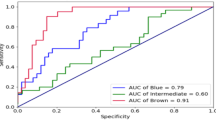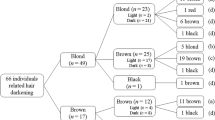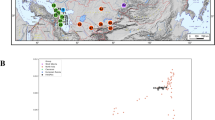Abstract
DNA phenotyping research is one of the most emergent areas of forensic genetics. Predictions of externally visible characteristics are possible through analysis of single nucleotide polymorphisms. These tools can provide police with “intelligence” in cases where there are no obvious suspects and unknown biological samples found at the crime scene do not result in any criminal DNA database hits. IrisPlex, an eye color prediction assay, revealed high prediction rates for blue and brown eye color in European populations. However, this is less predictive in some non-European populations, probably due to admixing. When compared to other European countries, Portugal has a relatively admixed population, resulting from a genetic influx derived from its proximity to and historical relations with numerous African territories. The aim of this work was to evaluate the utility of IrisPlex in the Portuguese population. Furthermore, the possibility of supplementing this multiplex with additional markers to also achieve skin color prediction within this population was evaluated. For that, IrisPlex was augmented with additional SNP loci. Eye and skin color prediction was estimated using the multinomial logistic regression and binomial logistic regression models, respectively. The results demonstrated eye color prediction accuracies of the IrisPlex system of 90 and 60 % for brown and blue eye color, respectively, and 77 % for intermediate eye color, after allele frequency adjustment. With regard to skin color, it was possible to achieve a prediction accuracy of 93 %. In the future, phenotypic determination multiplexes must include additional loci to permit skin color prediction as presented in this study as this can be an advantageous tool for forensic investigation.



Similar content being viewed by others
References
Poetsch M, Blohm R, Harder M et al (2013) Prediction of people’s origin from degraded DNA—presentation of SNP assays and calculation of probability. Int J Leg Med 127:347–357. doi:10.1007/s00414-012-0728-0
Keating B, Bansal AT, Walsh S et al (2013) First all-in-one diagnostic tool for DNA intelligence: genome-wide inference of biogeographic ancestry, appearance, relatedness, and sex with the Identitas v1 Forensic Chip. Int J Leg Med 127:559–572. doi:10.1007/s00414-012-0788-1
Walsh S, Liu F, Wollstein A et al (2013) The HIrisPlex system for simultaneous prediction of hair and eye colour from DNA. Forensic Sci Int Genet 7:98–115. doi:10.1016/j.fsigen.2012.07.005
Pospiech E, Draus-Barini J, Kupiec T et al (2011) Gene-gene interactions contribute to eye colour variation in humans. J Hum Genet 56:447–455. doi:10.1038/jhg.2011.38
Pośpiech E, Wojas-Pelc A, Walsh S et al (2014) The common occurrence of epistasis in the determination of human pigmentation and its impact on DNA-based pigmentation phenotype prediction. Forensic Sci Int Genet 11C:64–72. doi:10.1016/j.fsigen.2014.01.012
Kayser M, Schneider PM (2009) DNA-based prediction of human externally visible characteristics in forensics: motivations, scientific challenges, and ethical considerations. Forensic Sci Int Genet 3:154–61. doi:10.1016/j.fsigen.2009.01.012
Walsh S, Liu F, Ballantyne KN et al (2011) IrisPlex: a sensitive DNA tool for accurate prediction of blue and brown eye colour in the absence of ancestry information. Forensic Sci Int Genet 5:170–80. doi:10.1016/j.fsigen.2010.02.004
Liu F, van Duijn K, Vingerling JR et al (2009) Eye color and the prediction of complex phenotypes from genotypes. Curr Biol 19:R192–3. doi:10.1016/j.cub.2009.01.027
Walsh S, Lindenbergh A, Zuniga SB et al (2011) Developmental validation of the IrisPlex system: determination of blue and brown iris colour for forensic intelligence. Forensic Sci Int Genet 5:464–71. doi:10.1016/j.fsigen.2010.09.008
Walsh S, Wollstein A, Liu F et al (2012) DNA-based eye colour prediction across Europe with the IrisPlex system. Forensic Sci Int Genet 6:330–40. doi:10.1016/j.fsigen.2011.07.009
(2004) Scientific Working Group on DNA analysis methods, revised validation guidelines. Forensic Sci. Commun. 6
Kastelic V, Pospiech E, Draus-Barini J et al (2013) Prediction of eye color in the Slovenian population using the IrisPlex SNPs. Croat Med J 54:381–386
Yun L, Gu Y, Rajeevan H, Kidd KK (2014) Application of six IrisPlex SNPs and comparison of two eye color prediction systems in diverse Eurasia populations. Int J Leg Med. doi:10.1007/s00414-013-0953-1
Dembinski GM, Picard CJ (2014) Evaluation of the IrisPlex DNA-based eye color prediction assay in a United States population. Forensic Sci Int Genet 9:111–117. doi:10.1016/j.fsigen.2013.12.003
Moorjani P, Patterson N, Hirschhorn JN et al (2011) The history of African gene flow into Southern Europeans, Levantines, and Jews. PLoS Genet 7, e1001373. doi:10.1371/journal.pgen.1001373
Plaza S, Calafell F, Helal A et al (2003) Joining the Pillars of Hercules: mtDNA sequences show multidirectional gene flow in the western Mediterranean. Ann Hum Genet 67:312–328. doi:10.1046/j.1469-1809.2003.00039.x
Kennedy H (1996) Muslim Spain and Portugal. A Political History of al-Andalus. Longman
Pinto AC, Lloyd-Jones S (2003) The last empire: thirty years of Portuguese decolonization. ix, 156 p
Han J, Kraft P, Nan H et al (2008) A genome-wide association study identifies novel alleles associated with hair color and skin pigmentation. PLoS Genet 4, e1000074. doi:10.1371/journal.pgen.1000074
Sulem P, Gudbjartsson DF, Stacey SN et al (2007) Genetic determinants of hair, eye and skin pigmentation in Europeans. Nat Genet 39:1443–1452. doi:10.1038/ng.2007.13, ng.2007.13 [pii]
Sulem P, Gudbjartsson DF, Stacey SN et al (2008) Two newly identified genetic determinants of pigmentation in Europeans. Nat Genet 40:835–7. doi:10.1038/ng.160
Branicki W, Brudnik U, Wojas-Pelc A (2009) Interactions between HERC2, OCA2 and MC1R may influence human pigmentation phenotype. Ann Hum Genet 73:160–170. doi:10.1111/j.1469-1809.2009.00504.x
Nan H, Kraft P, Qureshi A a et al (2009) Genome-wide association study of tanning phenotype in a population of European ancestry. J Invest Dermatol 129:2250–7. doi:10.1038/jid.2009.62
Spichenok O, Budimlija ZM, Mitchell AA et al (2011) Prediction of eye and skin color in diverse populations using seven SNPs. Forensic Sci Int Genet 5:472–478. doi:10.1016/j.fsigen.2010.10.005
Sturm RA, Frudakis TN (2004) Eye colour: portals into pigmentation genes and ancestry. Trends Genet 20:327–32. doi:10.1016/j.tig.2004.06.010
Sturm RA, Duffy DL, Zhao ZZ et al (2008) A single SNP in an evolutionary conserved region within intron 86 of the HERC2 gene determines human blue-brown eye color. Am J Hum Genet 82:424–31. doi:10.1016/j.ajhg.2007.11.005
Leite TK, Fonseca RM, de Franca NM et al (2011) Genomic ancestry, self-reported “color” and quantitative measures of skin pigmentation in Brazilian admixed siblings. PLoS One 6, e27162. doi:10.1371/journal.pone.0027162
Valenzuela RK, Henderson MS, Walsh MH et al (2010) Predicting phenotype from genotype: normal pigmentation. J Forensic Sci 55:315–322. doi:10.1111/j.1556-4029.2009.01317.x, JFO1317 [pii]
Lamason RL, Mohideen MA, Mest JR (2005) SLC24A5, a putative cation exchanger, affects pigmentation in zebrafish and humans. Science (80-) 310:1782–1786. doi:10.1126/science.1116238
Stokowski RP, Pant PV, Dadd T et al (2007) A genomewide association study of skin pigmentation in a South Asian population. Am J Hum Genet 81:1119–1132. doi:10.1086/522235
Dimisianos G, Stefanaki I, Nicolaou V et al (2009) A study of a single variant allele (rs1426654) of the pigmentation-related gene SLC24A5 in Greek subjects. Exp Dermatol 18:175–177. doi:10.1111/j.1600-0625.2008.00758.x
Soejima M, Koda Y (2007) Population differences of two coding SNPs in pigmentation-related genes SLC24A5 and SLC45A2. Int J Leg Med 121:36–39. doi:10.1007/s00414-006-0112-z
Fitzpatrick TB (1988) The validity and practicality of sun-reactive skin types I through VI. Arch Dermatol 124:869. doi:10.1001/archderm.1988.01670060015008
Walsh PS, Metzger DA, Higuchi R (1991) Chelex 100 as a medium for simple extraction of DNA for PCR-based typing from forensic material. Biotechniques 10:506–513
Sturm R (2009) Molecular genetics of human pigmentation diversity. Hum Mol Genet 18:R9–17. doi:10.1093/hmg/ddp003
Dieffenbach CW, Lowe TM, Dveksler GS (1993) General concepts for PCR primer design. PCR Methods Appl 3:S30–7
Vallone PM, Butler JM (2004) AutoDimer: a screening tool for primer-dimer and hairpin structures. Biotechniques 37:226–31
Hosmer DW Jr, Lemeshow S, Sturdivant RX (2013) Applied logistic regression, third edit. Wiley, New Jersey
Croissant Y (2013) mlogit: multinomial logit model. R package
R Core Team (2014) R: A language and environment for statistical computing
Lee K, Ahn H, Moon H et al (2013) Multinomial logistic regression ensembles. J Biopharm Stat 23:681–94. doi:10.1080/10543406.2012.756500
Ferri C, Hernández-Orallo J, Salido M (2003) Volume under the ROC Surface for Multi-class Problems. In: Lavrač N, Gamberger D, Blockeel H, Todorovski L (eds) Mach. Learn. ECML 2003 SE - 12. Springer Berlin Heidelberg, pp 108–120
Hand DJ, Till RJ (2001) A simple generalisation of the area under the ROC curve for multiple class classification problems. Mach Learn 45:171–186. doi:10.1023/A:1010920819831
Hilbe JM (2009) Logistic regression models. Chapman & Hall/CRC Press, Boca Raton
McCullagh P, Nelder JA (1989) Generalized linear models, second Edi. Chapman & Hall, London
Acknowledgments
The authors would like to express their sincere gratitude to all the volunteers who contributed to this work by providing samples. The authors would also like to thank two anonymous reviewers who gave valuable comments and advice on how to improve the content of this article.
Conflict of interest
The authors declare that they have no conflict of interest.
Ethical standards
All experiments were approved by the Governing board of the National Institute of Legal Medicine and Forensic Sciences, Portugal.
Author information
Authors and Affiliations
Corresponding author
Rights and permissions
About this article
Cite this article
Dario, P., Mouriño, H., Oliveira, A.R. et al. Assessment of IrisPlex-based multiplex for eye and skin color prediction with application to a Portuguese population. Int J Legal Med 129, 1191–1200 (2015). https://doi.org/10.1007/s00414-015-1248-5
Received:
Accepted:
Published:
Issue Date:
DOI: https://doi.org/10.1007/s00414-015-1248-5




